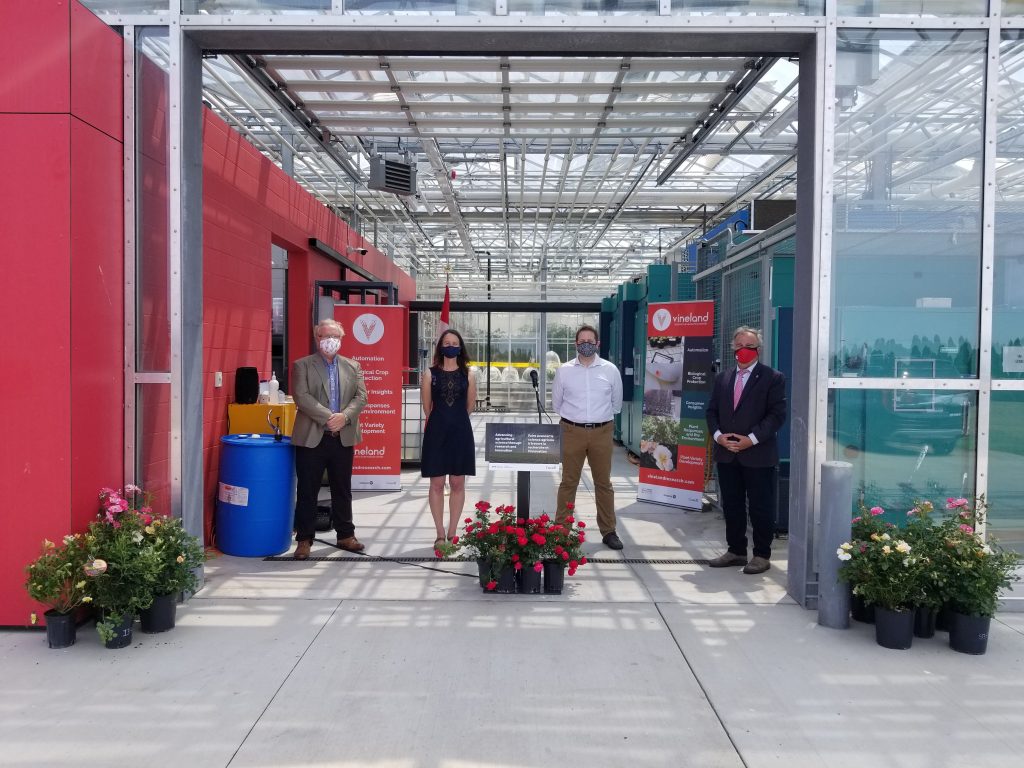
News
Research
Vineland’s horticultural projects to receive $4 million boost in federal funds
July 9, 2021 By Greta Chiu
 From left to right: Ian Potter, PhD, Vineland’s President & CEO; Tania Humphrey, PhD, Vineland’s Vice President, Research & Development; Chris Bittle, Member of Parliament for St. Catharines; Parliamentary Secretary to the Minister of Environment and Climate Change Neil Ellis. Photo credit: AAFC
From left to right: Ian Potter, PhD, Vineland’s President & CEO; Tania Humphrey, PhD, Vineland’s Vice President, Research & Development; Chris Bittle, Member of Parliament for St. Catharines; Parliamentary Secretary to the Minister of Environment and Climate Change Neil Ellis. Photo credit: AAFC Vineland Research and Innovation Centre has received nearly $4 million in federal funding to support four horticultural research projects.
Bred-for-Canada tomatoes
Up to $1.8 million will support Vineland’s on-the-vine breeding program for greenhouse tomatoes, said to be the first of its kind in Canada. The program focuses on developing high-yielding varieties with flavour and production traits adapted to Canada’s climate.
“This project will build on previous work by our research team to develop Canada-adapted tomato-on-the-vine genetics with traits for high yield and preferred flavour,” says Dr. Tania Humphrey, vice president of research and development at Vineland.
Recently, the research institution shared news of their work to identify and incorporate traits for resistance to the tomato brown rugose fruit virus. Humphrey says the group will also work towards further improvements in flavour and new tools to advance new varieties in the future.
Hardy rose program
Vineland will also receive up to $877,000 to help Canadian roses become more disease-resistant and adaptive, reaching a greater number of domestic and international markets.
Common rose varieties lack black spot resistance and cold hardiness, explains Humphrey.
Between 2017 to 2021, Vineland released three roses in the 49th Parallel collection, which stem from the research conducted in the national breeding program in collaboration with the Canadian Nursery and Landscape Association. A fourth rose is already on the way.
“Our goal is to evaluate and select roses to continue to fill the 49th Parallel Collection with these unique types of roses over the next 5 years,” says Humphrey. The team will be looking to layer on added resistance to Cercospora or powdery mildew.
“That these roses also have the ornamental value required by the nursery sector and consumers for appearance, fragrance and growth habit in addition to disease resistance and cold hardiness ensures the best chance for commercial success in domestic and international markets.”
New biocontrol solutions
A further $931,000 will support Vineland’s work to discover and evaluate new biocontrol solutions for the Canadian greenhouse sector.
The research institution will be working with Canadian researchers and industry partners to identify and develop biological control agents indigenous to Canada, targeting key pests such as aphids, thrips and mealybugs.
“By the end of the project, we will have completed proof-of-concept studies on scientifically validated and proven biocontrol candidates, and several prototype products will be available to industry partners for final stage scaling up and “finishing” to make them into viable commercial products,” says Humphrey.
The value of horticultural waste
The fourth project, receiving up to $200,000, will work towards converting horticultural waste into value-added ingredients in Canada. This will be conducted in three parts: opportunity mapping, economic cost-benefit analysis, and an apple pomace case study.
Opportunity mapping will focus on green nursery waste as well as the top six edible horticultural crops, determined by production weight. “These include field tomatoes, apples, carrots, greenhouse tomatoes, onions and greenhouse cucumbers,” says Humphrey.
The economic cost-benefit analysis will then compare “the opportunity trade-offs between compost manufacturing and waste conversion to a value-added ingredient for sale to other industries.”
As for the apple pomace case study, it will develop apple pomace powder formulations suitable for specific applications by conducting processing trials, developing test formulations for targeted applications (e.g. recipes for sausage, apple pie filling), then testing their performance.
The investments above are part of the federal AgriScience Program and Canadian Agricultural Strategic Priorities Program, building on previously announced support from the governments of Canada and Ontario of more than $330,000 to support VRIC research projects.
Research updates can also be found in Vineland’s 2020-2021 Innovation Report.
With files from: Agriculture and Agri-Food Canada
Print this page